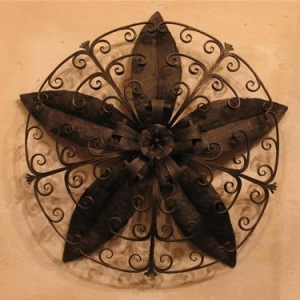Artistic forging

Blacksmithing is one of the oldest crafts, consisting of rather complex technological processes. They necessitated the equipment of special premises – smithies equipped with forge and bellows, as well as a variety of forging tools (anvil, mites, hammers, files, etc.). Because of the increased fire danger, smithies were always located on the outskirts of settlements. Therefore, the blacksmiths residing on the outskirts seemed mysterious to neighbors, often considered shamans, and sometimes – sorcerers associated with evil forces. At the same time, it was believed in Russian villages that the smith can not only forge a plow or a sword, but also treat illnesses, arrange weddings, tell fortunes, drive away evil spirits. People, though afraid of smiths, but respected them, giving due to the necessary for this profession qualities – strength, agility and courage.
Blacksmithing was widespread in ancient Russian cities and villages. Russian blacksmiths possessed all the basic techniques of processing iron, copper and its alloys, as well as silver and gold. Everything that was required in everyday life was produced - axes, knives, hoops for barrels and tubs, nails, sickles, shovels, frying pans, massive riveted sheets of boilers, various locks (from simple to complex, with intricate mechanisms) and many other products. In blacksmith workshops weapons and military equipment was forged – swords, spears, helmets, chain mails. Blacksmiths could do fine work, producing decorative things and jewelry. Until the 19th century, technology of forging of metal practically did not change. With the development of scientific and technological progress, the blacksmith's hand-made business was displaced by the factory production line with hydraulic hammers and rolling mills.
However, even today forge craftsmen are retaining, for example, handmade art forging and making piece products. In the very center of Vladimir, on pedestrian Georgievskaya street, there is an operating smithy of the hereditary blacksmiths Borodins, which today is the center of conservation of blacksmith's craft and folk traditions. This is a real art creative workshop, working with a red-hot metal, where old unique technologies of forging are used.
Master smith Yuri Borodin has designed many museums on the Vladimir land with his works. Blacksmiths Borodins participated in the restoration of monuments of history and culture in Suzdal, Vladimir, Murom, Gus-Khrustalny, Gorokhovets.
In the forge of Borodins ancient and modern works of decorative and applied art are presented. They are executed both in the traditions of Russian folk forging and in new techniques of jewelry forging. Decorative forged panels amaze with complex subjects, ease and grace. They are unique in their essence. Blacksmiths Borodins participate in all-Russian and international art exhibitions.
Today blacksmiths Alexei and Yuri Borodins conduct master classes on which you can learn about the peculiarities of the ancient blacksmithing technology, feel the heat of the red-hot metal, hold a real forging tool. Masters help visitors to forge a nail on their own for memory, because in Russia it was the nail that was considered the symbol of the beginning and the end of the house's construction. The nail taken in the way should remind us of home and protect from all misfortunes. Newlyweds can forge a horseshoe for luck.
Address: Vladimir, Georgievskaya street, 3g
Phone: +7 (915) 760-21-77 (Alexey Borodin)
Website: www.kuznica33.ru
E-mail: kuznica33@inbox.ru
 Tourism portal of the
Tourism portal of the